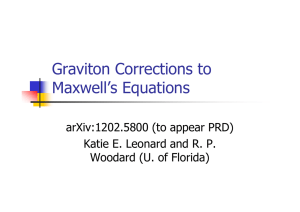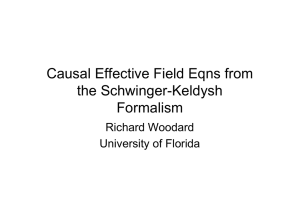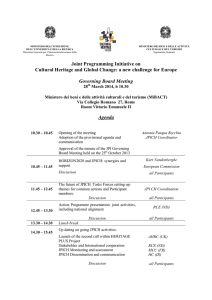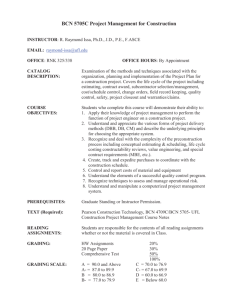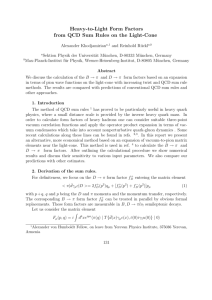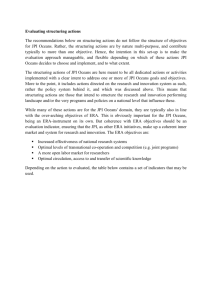Graviton Corrections to Maxwell’s Equations arXiv:1202.5800 (to appear PRD)
advertisement
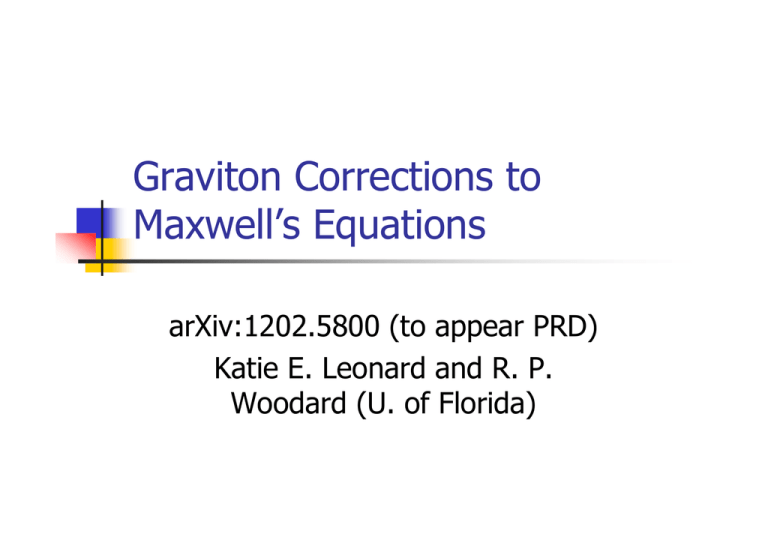
Graviton Corrections to
Maxwell’s Equations
arXiv:1202.5800 (to appear PRD)
Katie E. Leonard and R. P.
Woodard (U. of Florida)
Classical Maxwell’s Equations
gνρgµσFρσ]
µ
µ
∂ν [√-g
=J
1.
Photons (J = 0)
Ei(t,x) ~ εi e-ik(ct-x)
µ
Static point charge (J =
2.
µ 3
qδ 0δ (x))
A0(t,x) = q/[4π r]
Instantaneous dipole
3.
J0 = -θ(t)pi∂iδ3(x) , Ji = piδ(t)δ3(x)
Fij(t,x} = -1/2π (∂ipj-∂jpi) θ(t) δ(r2–t2)
Quantum-Correcting Maxwell
∂ν[√-g gνρgµσFρσ(x)]
+ ∫d4x’[µΠν](x;x’) Aν(x’) = Jµ(x)
1PI 2-pt function: i[µΠν](x;x’)
1PI 1-pt function: Jµ(x)
Specialization to flat space
[µΠν](x;x’) = (ηµν∂2 - ∂µ∂ν) Π(∆x2)
∂νFνµ(x) + ∫d4x’ Π(∆x2) ∂’νFνµ(x’) = Jµ(x)
No Integrals at One Loop!
i[µΠν]3pt = ∂κ∂’θ{iκVµρκλαβ i[αβ∆γδ] iκVνσφθγδ ∂λ∂’φ i[ρ∆σ]}
= -κ2Γ2(D/2-1)/16πD (D-3)(D-2)2D
• {(D+1)ηµν/∆x2D -2D∆xµ∆xν/∆x2D+2}
= Same • 1/[2(D-1)] [ηµν∂2 - ∂µ∂ν] 1/∆x2D-2
Schwinger-Keldysh Formalism
(converting in-out to in-in)
End of each line gets ± polarity
Vertices all + (normal) or all – (-normal)
Just replace ∆x2 in propagators
++ ||x - x’||2 – (|t - t’| - iε)2
+- ||x - x’||2 – (t - t’ + iε)2
-+ ||x - x’||2 – (t - t’ – iε)2
-- ||x - x’||2 – (|t - t’| + iε)2
In-out N-pt function gives 2N in-in N-pt
SK Effective Field Equations
Πin-out Π++ + Π+
ln(µ2∆x2)/∆x2 = ⅛ ∂2[ln2(µ2∆x2) – 2ln(µ2∆x2)]
t’ > t ++ and +- cancel
∆r > ∆t ++ and +- cancel
∆r < ∆t +- = -(++)*
ln(µ2∆x2++) – ln(µ2∆x2+-) = iπ θ(∆t-∆r)
ln2(µ2∆x2++) – ln2(µ2∆x2+-)
= i2π θ(∆t-∆r) ln[µ2(∆t2-∆r2)]
Π(x;x’) = G/24π2 ∂6{θ(∆t-∆r)
[ln[µ2(∆t2–∆r2)] – 1]} + O(G2)
No Change for Photons
∂νFνµ(x) + ∫d4x’ Π(x;x’)∂’νFνµ(x’) = Jµ(x)
∂νFνµ(x) = 0 works for Jµ = 0
Should be true to all orders
UV Enhancement for Coulomb
Φ(r) = q/4πr [1 + 2G/3πr2 + O(G2)]
Same sign as S-matrix techniques
#G/r2 fixed by dimensionality
No dependence on finite part of counterterm
Radkowski (1970)
Bjerrum-Bohr (2002)
Opposite to RG flow from β-function
Robinson & Wilczek (2006)
Harst & Reuter (2011)
But other things matter
Light-Cone Pushed Out
Point dipole pi created at t=0
Induced Fij(t,x) = -θ(t) (∂ipj - ∂jpi) X
J0(t,x} = -θ(t) pi∂i δ3(x)
Ji(t,x} = pi δ(t)δ3(x)
0 Loop: δ(r2 – t2)/2π
1 Loop: -4G/3π δ’(r2 – t2)/2π
Hence δ(r2 – t2 – 4G/3π) + O(G2)
Super-luminal but Poincare invariant
Smearing of the Light-Cone
An old idea (Pauli 1956, Deser 1957)
Something quantum gravity should do
i∆[g](x;x’) = 1/{2π σ[g](x;x’)} + O(lnσ)
2
4
∫d x’ {i∆[g](x;x’)} doesn’t exist
2
4
But hΓ[dg] ∫d x’ {i∆[g](x;x’)} might
Light-cone is a quantum operator
S-luminal propagation thru fluctuations
We might (eventually) build starships
Summary
νµ
∂νF (x) +
νµ
µ
Π(x;x’)∂’νF (x’) = J (x)
Π = G/(24π) ∂6 {θ(∆t-∆r) [ln[µ2(∆t2-∆r2)] - 1]} + O(G2)
Dynamical photons unchanged
Φ(r) q/(4πr) [1 + 2G/(3πr2) + O(G2)]
Pulse r2 = t2 + 4G/3π + O(G2)
∫d4x’
NB Poincare invariance inevitable in pert.
Gauge dependence requires work
But S-matrix results gauge independent
